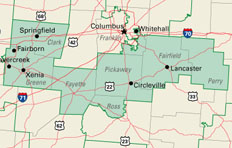Search
Constituent Services
District Map
District Map
E-Newsletter
Media Profiles
Contact Steve
Search a Bill
Kids Corner
Office Locations
-
Office Locations
Washington D.C. Office
439 Cannon House Office Building
Washington, DC 20515
Phone: (202) 225-4324
Fax: (202) 225-1984Springfield District Office
5 W. North Street, Suite 200
Springfield, Ohio 45504
Phone: (937) 325-0474
Fax: (937) 325-9188Lancaster District Office
207 S. Broad Street
Lancaster, Ohio 43130
Phone: (740) 654-5149
Fax: (740) 654-7825
 |
LANGUAGE CONGRESSMAN AUSTRIA HELPED SECURE TO OPEN UAS AIRSPACE NEAR WPAFB PASSES HOUSE
Friday April 01, 2011WASHINGTON, D.C. – Today, the House of Representatives passed the FAA Reauthorization and Reform Act of 2011 (H.R. 658), which includes language that U.S. Congressman Steve Austria (OH-Beavercreek) helped secure that aims to help the Air Force in its effort to gain “restricted” airspace near Wright-Patterson Air Force Base (WPAFB). This will allow the Air Force Research Laboratory (AFRL) and the Springfield National Guard to test Unmanned Aerial Systems (UAS), which would also open the door for industry development, training and commercial manufacturing. In securing this language, Austria creates the potential to bring hundreds of jobs and business development to Ohio.
“This language gets us one step closer to opening the way for UAS testing at Wright-Patterson Air Force Base and the Springfield National Guard,” Austria said. “Having approved airspace would provide a greater incentive for manufacturers to come to Ohio and bring hundreds of innovative and good-paying jobs to our state.”
“Garnering UAS test space near and around WPAFB is critically important for much of the research and development that takes place in the Dayton region because it will help reduce the test and evaluation time for many of the critical technologies required to enhance the flight safety of UASs operating in civilian airspace,” said Dennis Andersh, SAIC Dayton Regional Account Executive.
The FAA Reauthorization bill passed the House by a vote of 223 to 196. The bill will now go to Conference, where it will be reconciled with the Senate FAA bill (S. 385), in which Ohio Senators Sherrod Brown (D-OH) and Rob Portman (R-OH) championed similar language, and which was passed on February 17, 2011. Congressman Austria will work with House Transportation Chairman John Mica (FL-7) and his colleagues to continue fighting to ensure that the House language remains in the final bill.
Specifically, the language directs the FAA Administrator to establish a pilot program to integrate UASs into the national airspace system at a minimum of four test sites. In determining these locations, the FAA must also consult with the Administrator of National Aeronautics and Space Administration (NASA) and the Secretary of the Air Force while considering the availability of the research radars essential for testing UASs and their impact.
While this language does not guarantee that Ohio will get one of these test sites, it does ensure that WPAFB and the Springfield National Guard – who already have these capabilities in place – will have a seat at the table. This designation would enable the Air Force to develop and test UASs within the same region, which would significantly decrease the taxpayer burden associated with transporting and relocating these radars and vehicles. This will also allow the Springfield National Guard to continue to utilize its tower operations.
“WPAFB has been at the forefront of UAS development, and is an ideal location for one of these pilot programs,” Austria said. “One of the biggest challenges has been trying to gain airspace from the FAA. This bill will greatly ease this process.”
UASs are Unmanned Aerial Vehicles (UAV) plus the ground control system and supporting data links. A UAV is a controlled, reusable aircraft that flies without a human crew on board. Because of safety concerns, UAVs can only be flow in special regions designated by the FAA where the vehicles will not fly near commercial and general aircraft, or large population centers.
-30-














